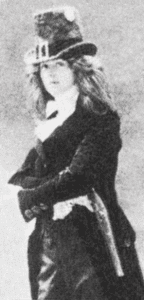In choosing the order of the poems and translations in A Crown of Violets, Samantha Pious has not held anything back about the in-your-face sexiness (the academic phrase would be “the transgressive nature”) of Renée Vivien and her work. The book begins with this poem, titled “Victory”:
Give me kisses bitter as your tears tonight,
When birds pause in their flight to wait.
Our long loveless unions have the charms
Of plunder, and the feral lure of rape.Your eyes reflect the splendor of the storm…
Breathe out your scorn until you swoon away,
My very dear!—Unclose your lips in wrath:
I’ll slowly drink their poison and their rage.Roused as a pirate before his precious spoils,
Tonight when all your gaze’s glow has fled,
The conqueror’s soul, savage and radiant,
Sings in my triumph as I leave your bed!
There it is, all of it: Vivien the lesbian lover, in butch pose and violent aspect. The poems, as they continue, leave no doubt that this is the woman who, in the words of Pious’s preface, “criticized heterosexuality, rejected marriage, celebrated infertility and virginity, and rebelled against the divine laws of a patriarchal, oppressive God.” For her attitudes toward heterosexual couples, see “The Grazers of Grass,” in which the poem’s subjects “ruminate in burblings of spit,” and for her attitude toward Christianity, see “I’ll Say This…,” in which she says to Christ, “I do not know you, and I never did.”
This was a confrontational stance, to say the least, when the poet took it over a century ago, in France at the turn of the twentieth century. And for many it’s confrontational now, as taken by Samantha Pious and by her publishers at Headmistress Press. Now, though, this stance has a devoted audience. Headmistress Press is described on its website as publishing “books by lesbians,” and it’s run by women as forthright and industrious as any I ever hope to meet. (Full disclosure: I’m straight, but I’ve conversed with the founders via poetry discussion boards for over a decade.) The book’s first edition, brought out in 2015, was gently criticized for lacking facing-page French originals, and the press has shown admirable commitment in bringing out a second edition quickly to supply that lack.
Having the French texts of the poems is an important help. They are a good selection of the poems that appeared in ten of the twenty-two books published under the name Renée Vivien, and one poem from the four books published under the name Paule Riversdale.(The poet’s given name was Pauline Tarn; she also wrote under that name, and her work appeared under the name of one of her several lovers as well.) The book makes the best-known of the French texts available again conveniently and affordably, with translations.
Those who can read French certainly should read the originals. Often in alexandrines (the twelve-syllable lines traditional in classical French poetry), and always using perfect rhymes, the French lines are the ones that convey fully the sensuality of sound that Vivien was after. Here is a taste of that, from “Les Noyees” (“The Drowned Women”):
Semblable aux algues d’ambre et d’or, leur chevelure
Fluide se répand en délicats réseaux,
Et leur âme est pareille aux conques où murmure
L’harmonie indécise et mouvante des eaux.
And Pious’s rendering:
Like seaweed made of amber or of gold,
Their hair spreads into lacework fluidly.
Their souls are like the conches that enclose
The sea’s uncertain, moving harmony.
Translation always sacrifices something, and Pious, in her translations, has been consistent about the choice to cleave to some formal principles and lean away from others. A doctoral candidate in comparative literature and literary theory, she is a specialist in Romance languages; we can trust her on the sense of the poems. She sticks (mostly) to a loose pentameter in translating the (mostly) twelve-syllable lines of the French and allows herself latitude with rhymes; for example, where the original has abab quatrains, Pious uses xaxa, with abundant slant, half-, and near rhymes.
Occasionally the need to rhyme nudges her word choice farther away from the original word than I would like, but rhyme and meter are important in these translations because the sound effects of form were clearly very important to Vivien. And at this point in poetry’s history and controversy, it’s crucial to point out (and Pious’s preface does point out) that rhyme and meter are not tied in any way to conservative social positions. They’re as useful for rejecting conventional mores as for embracing them.
And Vivien rejects them. Her life story, set in the France of the Belle Epoque, makes it clear that her verse is thinly disguised autobiography. The famous love affairs with several women—two of them as famous as herself—and the associated emotions belong to her, not to a constructed speaker. Her treatment of lovemaking is laid out as ornately as an X-rated film set:
I shiver, breathing in the warmth of furs
The blue of silver, or the blue of pearls;
I taste their scent, still stronger than the tastes
Of voices blaspheming in rut or blood,
And with an equal lust, I venerate
The Woman whom I fear, the Wildness that I love.
Even when she speaks in the persona of Sappho, riffing on Fragment 55, her perennial obsessions are there: sense details like clouds, veils, roses, song, perfumes, garlands—and her most lasting theme and Sappho’s subject in that fragment, death:
But Hell shall have you for its vague dominion,
Your lyric voice shall be a song gone by.
The memory of your perfumes will not last one hour.
Tomorrow you shall die.
So much scent, so many flowers, so much feminine stuff. And so many adjectives! Sometimes rendering in English only increases the density of modifiers:
My sensual hands glide through the gentle Furs,
Shivering as the sharp suspicion stirs
Of frightened beasts that flee the hunting calls…
This is a point that Pious felt she needed to address in a note to the second edition. She says “The axioms of Ezra Pound—a real poet is strong, male, and Whitmanianly yawping—have contributed to a general prejudice among American writers against softness, femininity, and flowers.” The prejudice, I have to note, was pounded into the poetry reader’s psyche much more recently than Pound, by John Ciardi as poetry editor of The Saturday Review, and is reinforced to this day in online poetry critiques. It’s a point made against other women poets, like Aemilia Lanyer, the first woman to publish a substantial book of poetry in English, who was ridiculed by her earliest twentieth century critics as merely pious and long-winded. It’s a prejudice we need to examine. To dislike the sensuous is to dislike, for example, Rimbaud, one of the Symbolists whom Vivien resembles in style, though she wrote later. And to dislike adjectives with no further qualification is to write off, for example, Dylan Thomas.
The aspects of Vivien’s work that give me pause—and that Pious treats faithfully—are the frank association of sex with violence, first, and the death fixation second. The poem “Desire” is an unnerving example of both, especially in its final lines:
Then, the sharp strangling of the plaintive voice,
The fearful silence, bringing dread that lingers,
And on the neck, as though on some dead stem,
The pallid, green-tinged markings of her fingers.
There’s reason to be hesitant about some of this; so much love of death is probably what killed Vivien in 1909 at the early age of thirty-two. Still, the strangeness itself is fascinating, and one has the sense that our fascination is Vivien’s aim. She is an exotic, and for those times when your mood runs to the exotic, Samantha Pious has brought her within easy reach.






